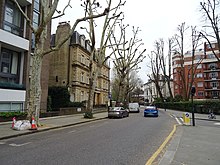Addison Road, London
 View in Addison Road | |
| Namesake | Joseph Addison (1672–1719), essayist and statesman |
|---|---|
| Type | Street |
| Location | Royal Borough of Kensington and Chelsea, London, England |
| Postal code | W14 |
| Nearest metro station | Holland Park tube station |
| Coordinates | 51°30′09″N 0°12′34″W / 51.50246°N 0.20932°W |
| North end | Holland Park Avenue |
| Major junctions | Holland Park Gardens, Melbury Road, Holland Park Road |
| South end | Kensington High Street |
| North | Addison Avenue |
| East | Woodsford Square |
| South | Warwick Gardens |
| West | Addison Crescent |
| Construction | |
| Construction start | 1820s |
| Other | |
| Known for | Literary connections; expensive properties |
Addison Road[1] is a road in London, England, which connects Kensington High Street with Notting Hill and Holland Park Avenue, and runs nearby to Holland Park.[2]
History and residents
[edit]
The name of the road derives from the essayist and statesman Joseph Addison (1672–1719),[1] as with Addison Avenue nearby.[3]
The road was begun in the 1820s. The church of St Barnabas at No. 23 was built in 1829, designed by Lewis Vulliamy[1] in a Tudor Gothic style,[4] with later stained glass by Edward Burne-Jones (executed by Morris & Co.) and Byam Shaw. St James Norlands Church at the far end of Addison Avenue also designed by Vulliamy, was built in 1845.
Debenham House at 8 Addison Road was designed for Sir Ernest Debenham in 1905–6 by Halsey Ricardo.[5] The Arts and Crafts-style house is an example of "structural polychromy". It includes Byzanto-Italianate grey bricks, Doulton Carrara ware, green-glazed bricks, and turquoise tiles. Inside, there is a dome and Arts and Crafts decoration.
From 1869 to 1916, there was an Addison Road station to the west of Addison Road itself, for a railway line that provided services between Waterloo and Richmond.[6]
Addison Road is home to the Cardinal Vaughan Memorial School, a Roman Catholic boys' school (which permits entry to girls in its Sixth Form).

The novelist and playwright John Galsworthy lived at 14 Addison Road from 1905 to 1913, as did Joseph Conrad and Radclyffe Hall at other times.[3] Other notable inhabitants have included:[1] Chaim Weizmann, the first President of the State of Israel, who lived at No. 67 between 1916 and 1919; David Lloyd George, who resided at No. 2 between 1928 and 1936;[7] James Locke, who is credited with giving Tweed its name, and the architect Eustace Balfour.[8]
Residential properties
[edit]
Debenham House, cited above, is often used for filming purposes. Although no longer privately owned, it is thought to be worth between £40–50 million.
The majority of houses located on Addison Road are worth between £10–30 million, and consequently the street is one of the most expensive residential streets in the world, and the second most expensive in London (behind Kensington Palace Gardens). In 2015, a property was sold for £30 million, the most expensive in the UK that year.[9]
Location
[edit]To the east is Holland Park. To the west is Holland Road and West Kensington. A portion of the road forms part of the A3220 leading to Warwick Gardens south of the junction with Kensington High Street.
Kensington Olympia railway station was originally named Addison Road although it is some distance away from the road itself.[10]
St Barnabas, Kensington, is a Church of England church in the road.[11][12]
See also
[edit]References
[edit]- ^ a b c d Weinreb, Ben; Hibbert, Christopher, eds. (1983). "Addison Road". The London Encyclopaedia. Macmillan. p. 5.
- ^ "Addison Road Guide — Holland Park, London W14". LondonTown.com. Retrieved 17 June 2023.
- ^ a b Addison Avenue, W14, The London Encyclopaedia, Pan MacMillan / Britain Express.
- ^ The Church of St. Barnabas, Addison Road Archived 24 October 2012 at the Wayback Machine, In "The Holland estate: Since 1874", Survey of London: volume 37: Northern Kensington, pp. 126–150. British History, English Heritage, 1973.
- ^ No. 8 Addison Road Archived 24 October 2012 at the Wayback Machine. In "The Holland estate: Since 1874", Survey of London: volume 37: Northern Kensington, pp. 126–150. British History, English Heritage, 1973.
- ^ Addison Road – Hammersmith (1869–1916), London's Abandoned Tube Stations, UK.
- ^ "David Lloyd George's house at 2 Addison Road". Historic England. Retrieved 12 December 2022.
- ^ "Colonel Eustace James Anthony Balfour". Dictionary of Scottish architects. Retrieved 22 June 2014.
- ^ Miller, Claire (2 February 2016). "The country's most expensive house to be sold in 2015 was sold for a whopping £30million". Daily Mirror. UK.
- ^ Allen, Cecil J. (August 1969). "Olympia and the West London line". Railway World. Vol. 30, no. 351. Shepperton: Ian Allan. pp. 342–347.
- ^ St Barnabas, Kensington.
- ^ St Barnabas Addison Road, London[permanent dead link], A Church Near You, Church of England.
External links
[edit] Media related to Addison Road, London at Wikimedia Commons
Media related to Addison Road, London at Wikimedia Commons
